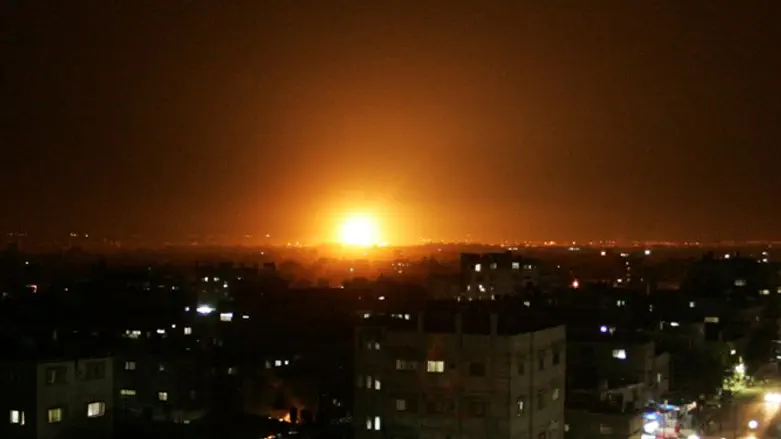
Multiple drones reportedly belonging to the Israeli Air Force (IAF) carried out a new series of airstrikes against Iranian-backed militias in the area of Deir Ez-Zur in eastern Syria over the weekend.
The London-based Syrian Observatory for Human Rights (SOHR) reported that a total of 8 airstrikes targeted the Afghan Liwa Fatemiyoun militia which was transferred to Syria on orders of Qassem Soleimani, the assassinated commander of the Quds Force of the Islamic Revolutionary Guards Corps.
The attack, which killed 12 Afghan militia members took place just before midnight on Sunday evening and destroyed recent fortifications and Iranian weapon deliveries to the bases of Liwa Fatemiyoun in the Deir Ez-Zur Province.
Although the IAF kept mum on the strikes, Rami Abdul Rahman, the director of SOHR, said he was confident Israel was responsible for the bombardment.
The incident on Sunday evening came just three days after Israeli warplanes used missiles to destroy another Iranian facility in west Syria in the vicinity of the city of Masyaf.
The Iranian staffed facility near Masyaf has been targeted before by the IAF and produces among other weaponry guided missiles. Syria reported that its air defenses were activated during the Israeli attack but no IAF plane was hit, a pattern that repeats itself every time Israel carries out airstrikes in Syria.
The attack on the Syrian Scientific Studies and Research Center, which is also known as CERS, a defense laboratory that manufactures chemical arms and advanced missiles was preceded by another Israeli aerial attack on Iranian militias in eastern Syria that killed five Iranian-trained fighters.
These attacks were successfully carried out despite the deployment of state-of-the-art Russian-made S300 and S400 surface-to-air missile batteries deployed in Syria on Assad’s request.
While the Russians have the ability to shoot down Israeli warplanes, the Kremlin has refrained from doing so thus far for political reasons Dmitry Danilov, head of the European Security Department of the Institute of Europe of the Russian Academy of Sciences and a professor at the Moscow State Institute of International Relations (MGIMO) revealed this weekend.
Danilov stressed that Moscow views both Syria and Israel as “partners in the Middle East conflict” but stopped short of explaining which conflict.
“For us, Israel is as much a partner in international relations, including in the Middle East, as is Syria,” according to the Russian scientist who explained that in a sense Russia “is falling in a trap because it’s difficult to respond to certain Israeli actions.”
Russia doesn’t “consider Israel an adversary” Danilov added while repeating Russia has the ability to attack Israeli warplanes but doesn’t want to do it.
Former Israeli Defense Minister Naftali Bennett reported in May that Iran was withdrawing some of its forces from Syria but sources inside the country put this claim to test over the weekend.
Instead of withdrawing forces Iran has simply changed its tactics in the devastated country.
According to Iranian analyst Mostafa Najafi, a staggering 53,000 Iranian-backed militia members have merged into the army of dictator Bashar al-Assad and are still present along the border with Israel wearing Syrian army uniforms.
“In times of crisis, Iran has shown that it is prone to change tactics, instead of strategies,” Najafi said.
The Iranian-backed forces are now preparing for a large-scale offensive in the Dara’a Province that borders on Jordan and the Yarmouk basin on the Golan Heights other Syrian sources told Iran Wire.
The city of Dara’a was the scene of the first uprising by Sunni Syrians against al-Assad and has again been the scene of violence this time directed at the Iranian forces recently.
According to these sources “Iranian elements in the Syrian regime’s army” have been pushing for the offensive under the excuse that the Syrian army is still fighting the Islamic State group which has no presence anymore near the Golan Heights.
The Iranians and their allies, among them Hezbollah from Lebanon, have taken over Syrian government buildings and civilian homes forcing the owners of these properties to flee with their families.
This Iranian action caused new popular unrest in Dara’a that has been free from Iranian forces since Russia intervened at the end of the offensive to liberate the Dara’a and Kuneitra Province by the pro-Assad coalition in 2018.
According to the same Syrian sources the Iranians and their allies have set up camp right next to the Israeli border disguised as Syrian soldiers and using Syrian army vehicles in an attempt to avoid Israeli strikes.
The Russians are aware of this development and attend meetings by the General Syrian staff but didn’t lift a finger to stop the deployment of Iranian troops along the Israeli and Jordanian border.
"The people of the western countryside (Dara’a and Kuneitra) are living in terror as a result of the disinformation campaign the regime is spreading, including threats of death and abuse against the people of Dara’a. This comes in addition to the theft, looting, and destruction of buildings and property, and the burning of agricultural crops, among other threats," another local Syrian source reported.
Hezbollah is, furthermore, exploiting the situation in southwestern Syria by smuggling drugs to Jordan. Drug traffickers who have been arrested have been released from jail after Hezbollah intervened and bribed local Syrian government officials.
The Israel Defense Forces (IDF) now started a massive drill in northern Israel close to the Syrian border. The IDF said that the exercise was meant to raise “combat efficiency” and was planned before news broke about the Iranian deceit and the military build-up along the Jordanian and Syrian border, according the Hebrew language Channel 7.